The Best Places for Beach Camping on the Olympic Peninsula
Waking up by the ocean, with the sound of the waves, is one of the most incredible experiences – and the moody, rocky beaches of the Olympic Peninsula are perfect for pitching a tent. But, you can’t just set up on any stretch of shoreline! This guide will tell you the best places for beach camping on the Olympic Peninsula, and some tips for a great camping experience.
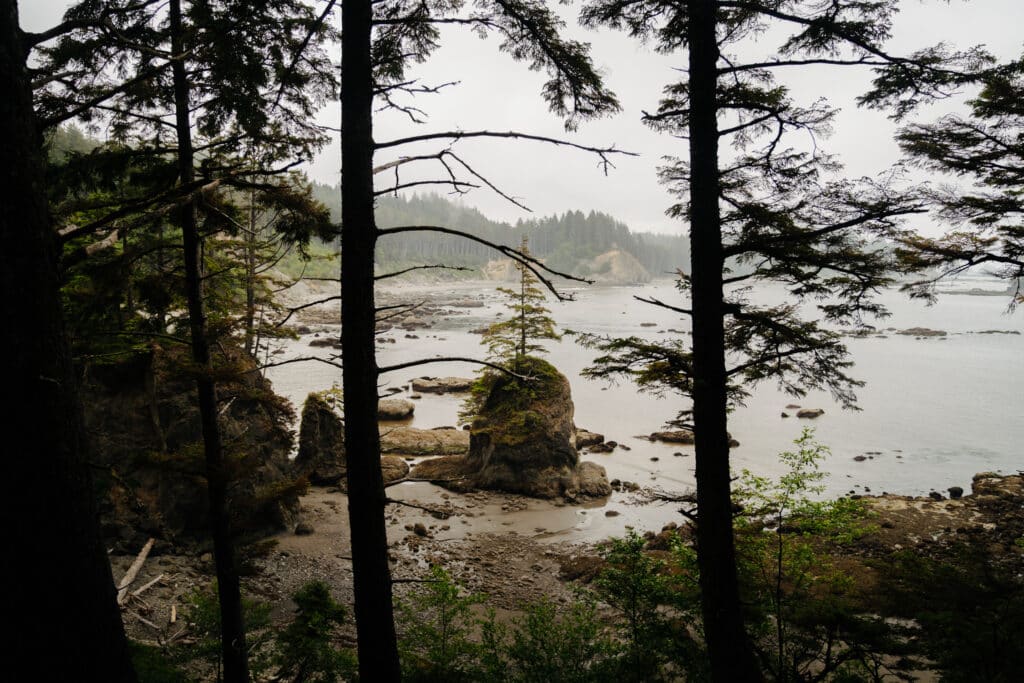
Head’s up: some of these links are affiliate links, so I get a commission if you make a purchase (at no cost to you). But that’s great, because I was going to share anyway, and this helps me keep making free guides for you!
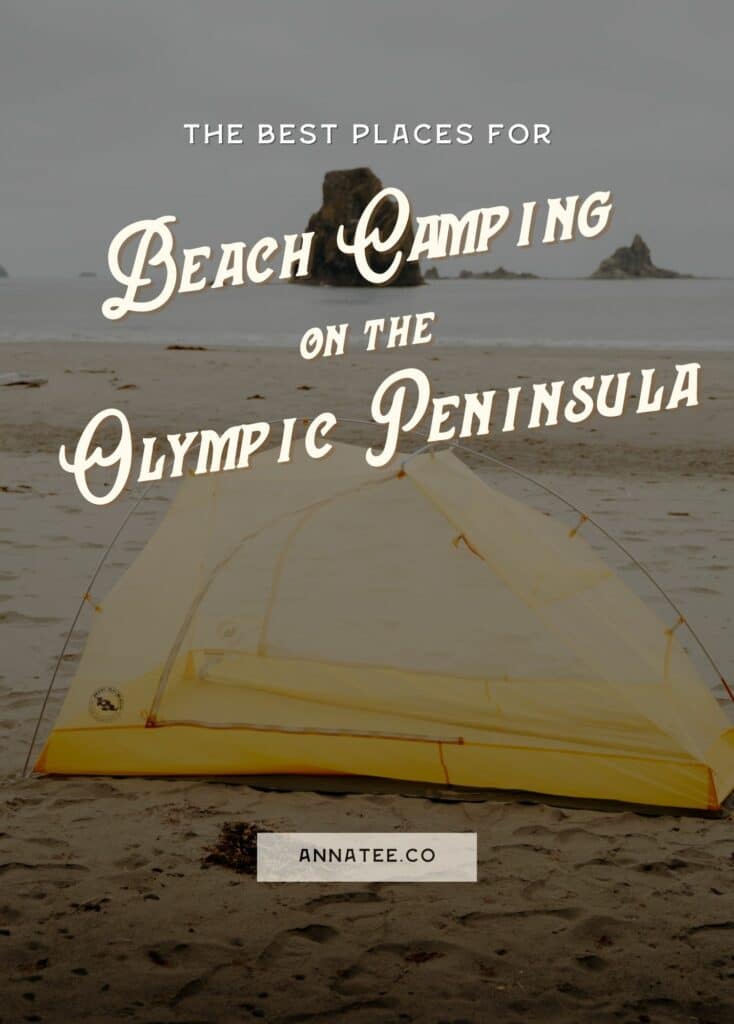
Table of Contents
Pin this photo to save this guide to beach camping on the Olympic Peninsula and reference it later!
Land Acknowledgement
Visiting the Olympic Peninsula means recreating on stolen land. There are several tribes that currently live on reservations in this area – Lower Elwha Klallam, Jamestown S’Klallam, Port Gamble S’Klallam, Skokomish, Quinault, Hoh, Quileute, and Makah. I encourage you to learn more by clicking any of those links, and by checking out Native Land to see whose land you’re on.
A portion of any income I make from this post, and this blog as a whole, is donated to various Indigenous Human Rights Organizations or directly to tribes. If you‘d like some examples of places to consider donating, I currently support Indigenous Roots and Real Rent Duwamish.
How to Find Beach Camping on the Olympic Peninsula
There are a lot of ways to find campsites, and one of the best is The Dyrt. With the free app, you can find campsites and places to stay – and with The Dyrt Pro, you can also create a road trip route and map out your trip! The Dyrt usually features paid campgrounds, which are great for people who want some amenities (like bathrooms, picnic tables, maybe even showers).

Try the Dirt Pro
Free for 30 days
Find campsites, plan road trips, and see the boundaries of national forest land where you can camp for free!
Things to Bring for Beach Camping on the Olympic Peninsula
When you camp on the beach, here’s what you’ll need to bring!
- Tent – somewhere to sleep! I love my super light Big Agnes Tiger Wall tent, and I also use a footprint to keep the bottom safe & dry.
- Sleeping Bag – make sure you have something warm enough! I use this ALPS Mountaineering sleeping bag.
- Sleeping Pad – an essential for a comfy night of sleep! I have this Sea to Summit pad, but am planning to upgrade to a thicker one, like this Therm-a-Rest pad soon!
- Camp Stove – there’s nothing like having a hot meal at camp. I use an MSR Pocket Rocket stove, which is incredibly small, along with this GSI Cookset.
- Bear Canister – on most (possibly all?) beaches on the Olympic Peninsula, food and any scented items are required to be kept in a bear canister. There aren’t bears on the beach, but the raccoons can be vicious. If you don’t have one, you can borrow one from the ranger station.
- Layers – you should always bring a rain jacket on the Olympic Peninsula! I like my Marmot PreCip a lot for wind and rain, and I recommend a fleece for warmth in the evening.
- Backpack – If you’re hiking to the beach you’re camping on, you’ll need a backpack big enough to carry everything! I use a Deuter backpacking pack.
- Headlamp – a camping essential for after dark.
- Water – before you leave for your camping trip, make sure you know the water situation at your destination. If fresh water (you can’t filter ocean water!) will be available, you might want to bring a filter, like the Sawyer Squeeze to ensure you can get more water. If there won’t be anywhere to filter water, make sure you bring enough for your trip.

Things to Know Before Beach Camping on the Olympic Peninsula
Beach camping on the Olympic Peninsula requires some planning! Here’s what you need to know before you go.
Permits for Beach Camping
Most beaches on the Olympic Peninsula require a permit, so you can’t just set up your tent whenever you feel like it! The process for getting a permit can vary a little, depending on where you decide to camp, so once you’ve decided on a beach, you’ll need to do some more research.
For wild camping, you’ll typically need a wilderness permit from Olympic National Park. When you go on Recreation.gov, click “Check Availability,” and you’ll need to select a starting area. The beach campsites will be under either “North Coast” or “South Coast.”
If you’re camping at an established campground, most of these are privately owned, and reservations can be made through them.
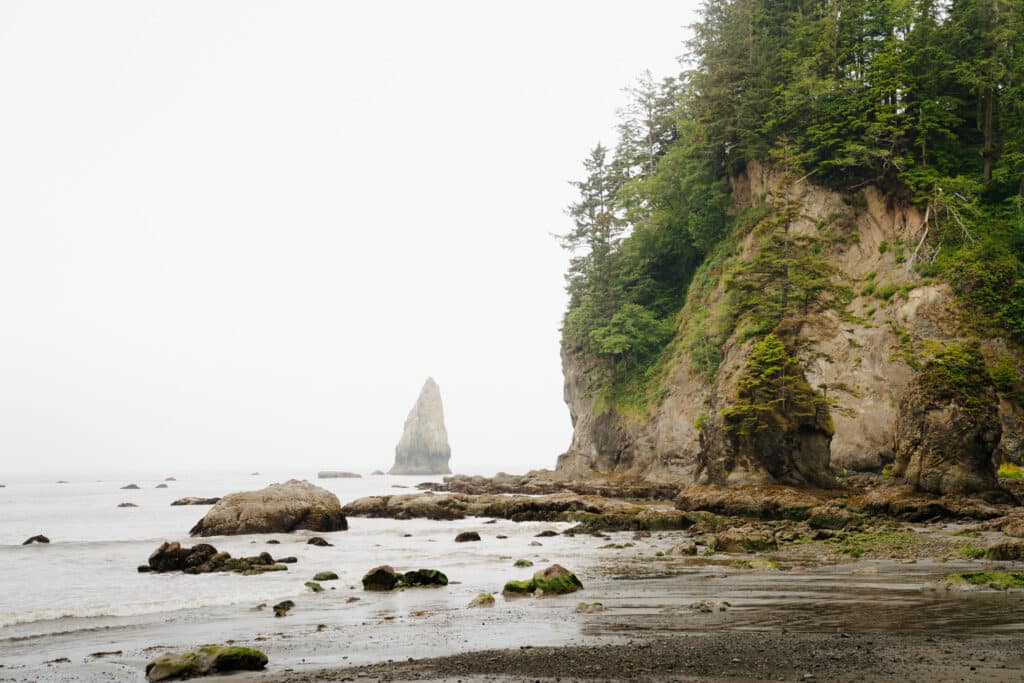
Leave No Trace
Anytime you’re outdoors, it’s essential that you practice Leave No Trace (LNT). LNT is a set of seven principles that help us understand our impact on the outdoors – because while we usually have good intentions, the environment is more fragile than we think, and one snap-second decision can cause damage to the environment that will take the earth years, even decades to repair.
Leave No Trace means enjoying the outdoors without disrupting nature, as much as it’s possible to do so. Here are the 7 principles of LNT, and how they apply when you’re beach camping on the Olympic Peninsula!
- Plan ahead and prepare – read this guide, make sure you know have the right gear, and be prepared for any weather.
- Travel and camp on durable surfaces – pitch your tent in designated campsites, or places that have been camped in before. Avoid trampling plants!
- Dispose of waste properly – don’t leave trash, or anything else, behind. Pack it out! If there are toilets, use them – but if not, bring a trowel and pack out your toilet paper.
- Leave what you find – I know it can be tempting to take a cool rock or shell, but leave these things where they belong! Animals often use these, and if everyone takes one, the beaches won’t be as pretty.
- Minimize campfire impacts – check to see if fires are allowed on the beach – they usually are, but you can only use driftwood.
- Respect wildlife – don’t approach wild animals, and never feed them. It’s bad for their stomachs, causes aggression, and messes with their natural patterns. Most beaches also require that you bring a bear canister! There are no bears on the coast, but there are raccoons that can aggressively try to eat your food.
- Be considerate of other visitors – respect your camping neighbor’s space, clean up after yourself, and avoid being too noisy.
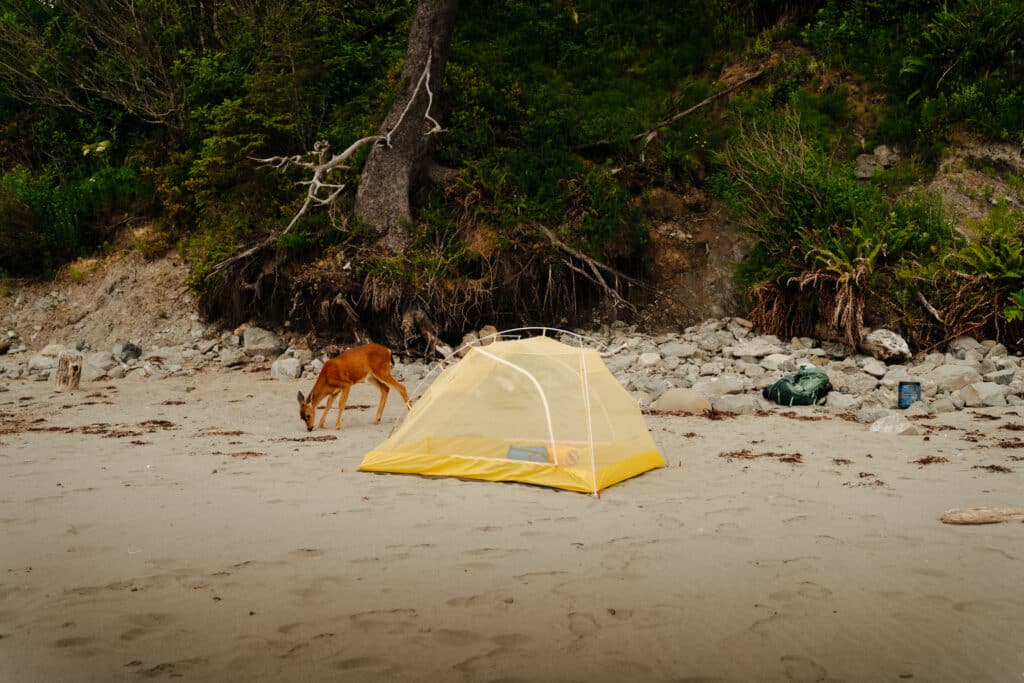
Tides
Another important thing to keep in mind when you go camping on the beach is that tides change! You definitely don’t want to find your tent getting soaked by the ocean in the middle of the night, so make sure you don’t set up camp too close to the water. Having a tide table will help, as it’ll let you know what time high and low tide are, but generally, make sure to set up far away from the water and closer to the tree line.
If you’re hiking to your beach camping location, there are some spots that you can’t even reach during high tide – like some beaches along the South Coast Trail, for example. So if that’s the case, tide tables are definitely important!

The Best Time for Beach Camping on the Olympic Peninsula
One thing you should definitely know about the Olympic Peninsula is that it’s really rainy!
The most popular time to visit is summer, when the area gets a short break from the rain. Summer is the best time for camping here in general, with warmer weather and clearer skies. But, late spring or early fall can also be good times for beach camping on the Olympic Peninsula, since the coastal regions usually have more mild temperatures, so while you’ll definitely need to be prepared for rain, the weather is usually warm enough to explore and enjoy the scenery – and you’re likely to have more privacy during the off season
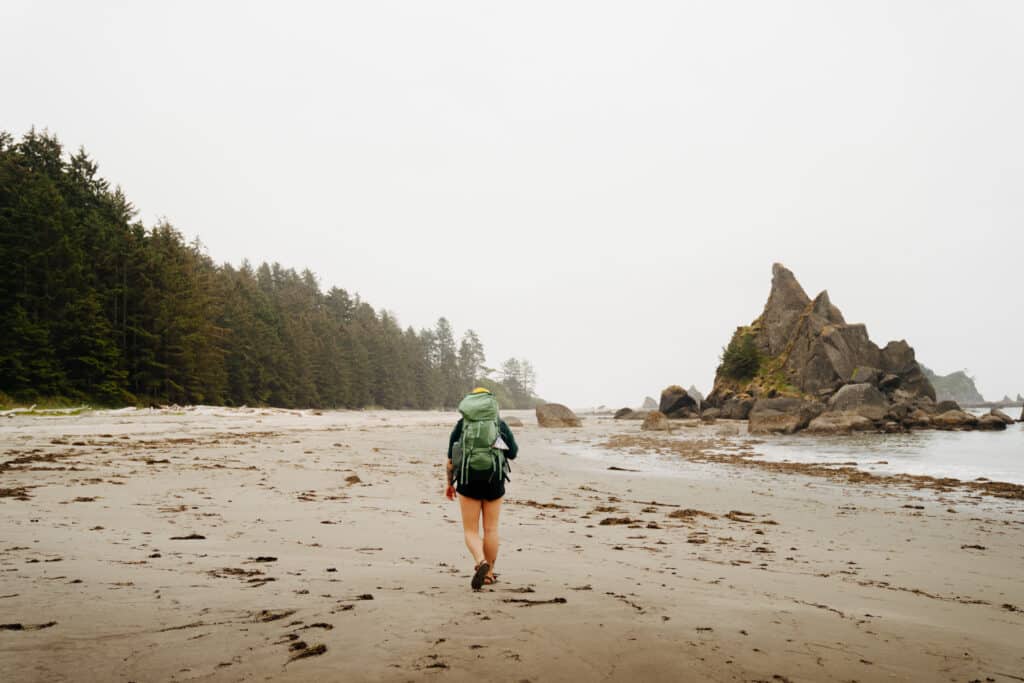
Map of Olympic Peninsula Beach Campsites
In the next section, I’ll talk about all of best places for beach camping on the Olympic Peninsula – but this map will give you an overview!
The green tent icons are easily accessible places to camp, the yellow ones require a short hike (under 2 miles), while the red ones require a longer hike of over 2 miles.
The Best Beach Camping on the Olympic Peninsula
Shi Shi Beach
Shi Shi (pronounced shy shy) Beach is a great beginner backpacking trip, with a gorgeous beach to camp on! The trail is often muddy, so make sure you have trails with good traction. The forested trail will lead you out to the beach, where you can enjoy sea stacks and tide pools.
Distance: 8.8 miles (14.16 km) out and back
Elevation Gain: 561 feet (171 m)
Difficulty: moderate
Hole-in-the-Wall
The walk to Hole-in-the-Wall starts at Rialto Beach. Make sure to do this when the tide is low, because if it’s over 6 feet, the beach will be covered. There’s no official trail here, as you just walk on the sand following the shoreline – while the hike is flat, it can sometimes get a little tiring to walk on soft sand! Still, it’s a great walk to see tide pools and rock formations, and the iconic Hole-in-the-Wall.
Distance: 3.3 miles (5.3 km) out and back
Elevation Gain: 108 feet (33 m)
Difficulty: easy

Second Beach
Second Beach is one of the most beautiful beaches I’ve ever seen! A short walk through the forest takes you to this beach, with sea stacks, tide pools, and incredible scenery. It’s an amazing place for beach camping, and the hike has a few short inclines, but nothing too strenuous.
Distance: 2.1 miles (3.4 km) out and back
Elevation Gain: 278 feet (85 m)
Difficulty: easy
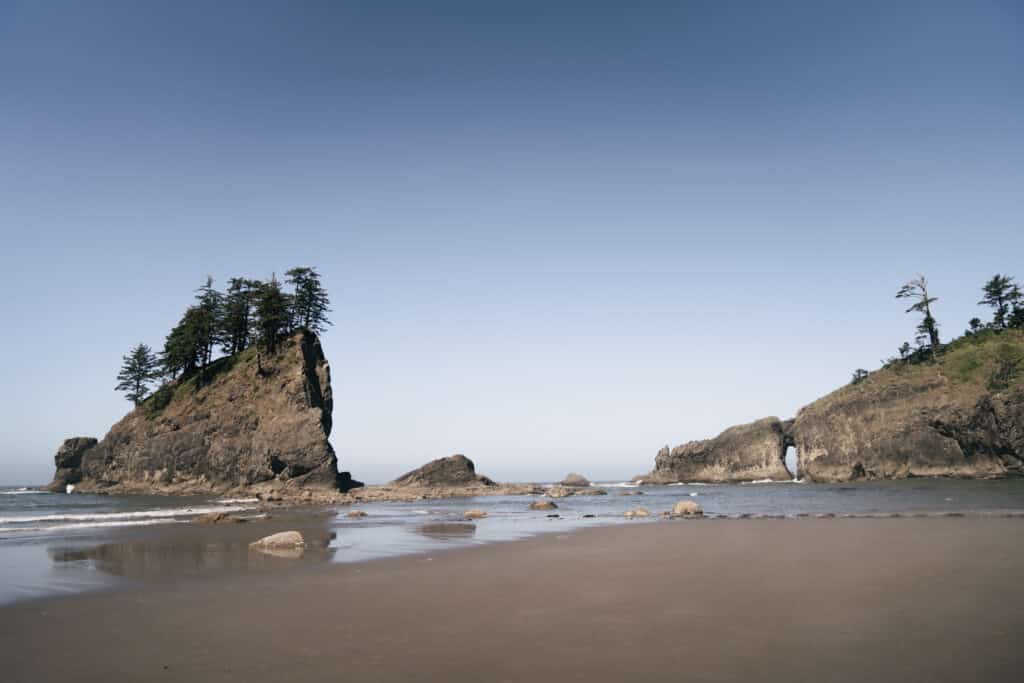
Third Beach
The hike to Third Beach is a nice walk through the woods that opens up to this gorgeous beach. This is the trailhead for the South Coast Wilderness trail, so if you want to turn this hike into a 17 mile backpacking adventure, this is where you start! But, if you just want a short, easy hike, this is a great place to camp on the beach.
Distance: 1.4 miles (2.3 km) out and back
Elevation Gain: 240 feet (73.2 m)
Difficulty: easy
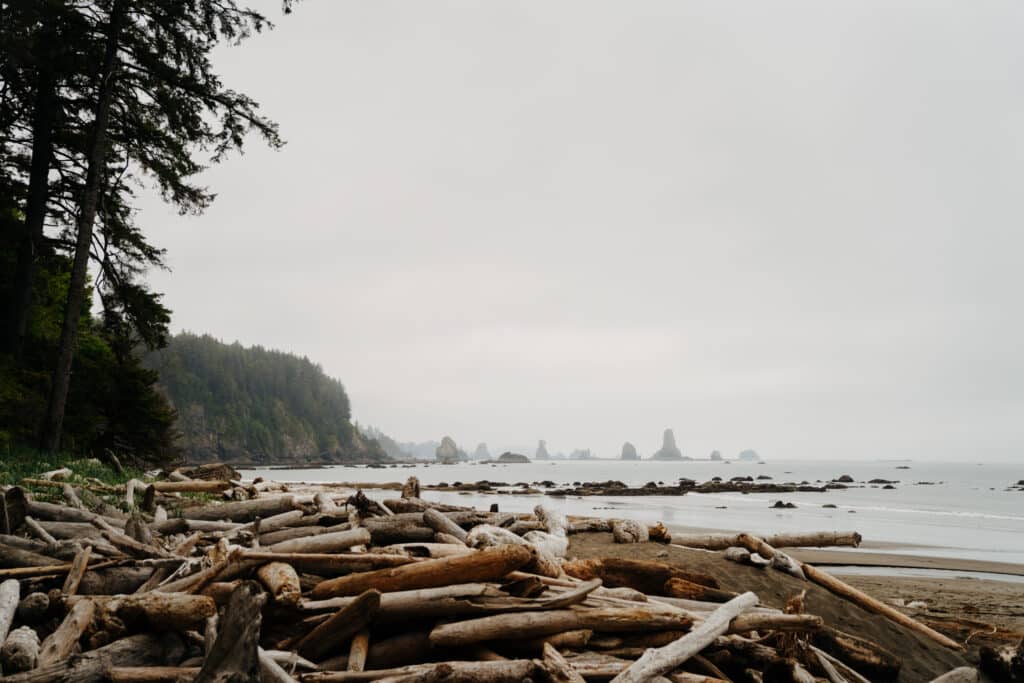
Toleak Point
Toleak Point is about 6.4 miles (10.3 km) south of Third Beach. Getting here is definitely an adventure, with lots of beach walking and steep ladders into the bluffs, but it’s so worth it! You can do this as an out and back hike from Third Beach, or do the entire trip along the South Coast Wilderness Trail. There are campsites in the treeline, but you can also set up your tent right on the beach!
Length (entire trail, not just to Toleak Point): 17 mile (27.36 km) thru-hike
Elevation Gain (entire trail): 1900 feet (579 m)
Difficulty: Moderate

Kalaloch Campground
This is the only developed campground on this list – which means that while the other spots have dispersed, “set up your tent anywhere on the beach” camping, this one has official campsites, including four accessible ones. Each site has fire rings and picnic tables, and the bathrooms have food lockers and drinking water – so this is the perfect place for camping if you want some amenities! The campground is on a bluff over the beach, but from the campsites closest to the water, you can get some ocean views, and the beach, and the Tree of Life that hangs between two cliffs, is a short walk away!

More Adventures
Have you visited the Olympic Peninsula, done some beach camping, or have any recommendations, tips, or questions? Let me know in a comment below!
If you’re visiting the Olympic Peninsula, make sure to check out this guide about planning a road trip to see more of it, and this guide about the best hikes in Olympic National Park. For more adventures in Washington
Pin any of these photos to reference this guide to beach camping on the Olympic Peninsula later!


